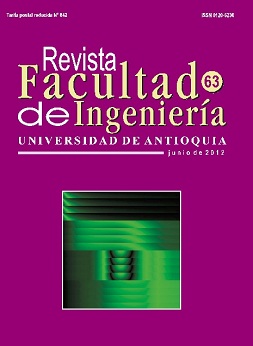Detección de daño en vigas utilizando redes neuronales artificiales y parámetros dinámicos
DOI:
https://doi.org/10.17533/udea.redin.12493Palabras clave:
redes neuronales, parámetros dinámicos, detección de dañosResumen
En este trabajo se presenta una red neuronal perceptron multicapa combinada con el método Nelder-Mead Simplex para detectar daño en vigas. Los parámetros de entrada a la red se basan en frecuencias naturales y flexibilidad modal. Se considera que solo una cantidad específica de modos fueron identificados y que se dispone de mediciones en grados de libertad verticales. La confiabilidad de la metodología propuesta se evalúa a partir de escenarios de daño aleatorios y de la definición de 3 tipos de error que la red puede cometer durante el proceso de detección del daño. Los resultados muestran que la metodología puede determinar confiablemente los escenarios de daño buscados. Sin embargo, su aplicación a vigas de gran tamaño puede verse limitada por el elevado costo computacional asociado al entrenamiento de la red.Descargas
Citas
S. Doebling, C. Farrar, M. Prime. “A Summary Review of Vibration-Based Damage Identification Methods”. The shock and vibration digest. Vol. 30. 1998. pp. 91- 105. DOI: https://doi.org/10.1177/058310249803000201
C. Chang, T. Chang, Y. Xu, M. Wang. “Structural Damage Detection Using an Iterative Neural Network” J. of Intelligent Material Systems and Structures. Vol. 11. 2000. pp. 32-42. DOI: https://doi.org/10.1106/XU88-UW1T-A6AM-X7EA
Y. Ni, B. Wang, J. Ko. “Constructing Input Vectors to Neural Networks for Structural Damage Identification”. Smart Materials and Structures. Vol. 11. 2002. pp. 825-833. DOI: https://doi.org/10.1088/0964-1726/11/6/301
X. Fang, H. Luo, J. Tang. “Structural Damage Detection using neural network with learning rate improvement”. Computers and Structures. Vol. 83. 2005. pp. 2150-2161. DOI: https://doi.org/10.1016/j.compstruc.2005.02.029
J. Lee, S. Kim. “Structural Damage Detection in the Frequency Domain using Neural Networks”. J. of Intelligent Material Systems and Structures. Vol. 18. 2007. pp. 785-792. DOI: https://doi.org/10.1177/1045389X06073640
G. Cybenko. “Approximation by superposition of a Sigmoidal Function”. Mathematics of Control, Signals and Systems. Vol. 2. 1989. pp. 303-314. DOI: https://doi.org/10.1007/BF02551274
B. Koh, S. Dyke. “Structural health monitoring for flexible bridge structures using correlation and sensitivity of modal data”. Computers and Structures. Vol. 85. 2007. pp. 117-130. DOI: https://doi.org/10.1016/j.compstruc.2006.09.005
O. Begambre. Algoritmo Híbrido para a Avaliação da Integridade Estrutural: Uma Abordagem Heurística. Tesis Doctoral. Universidad de São Paulo. São Paulo (Brasil). 2007. pp 152.
Descargas
Publicado
Cómo citar
Número
Sección
Licencia
Derechos de autor 2018 Revista Facultad de Ingeniería

Esta obra está bajo una licencia internacional Creative Commons Atribución-NoComercial-CompartirIgual 4.0.
Los artículos disponibles en la Revista Facultad de Ingeniería, Universidad de Antioquia están bajo la licencia Creative Commons Attribution BY-NC-SA 4.0.
Eres libre de:
Compartir — copiar y redistribuir el material en cualquier medio o formato
Adaptar : remezclar, transformar y construir sobre el material.
Bajo los siguientes términos:
Reconocimiento : debe otorgar el crédito correspondiente , proporcionar un enlace a la licencia e indicar si se realizaron cambios . Puede hacerlo de cualquier manera razonable, pero no de ninguna manera que sugiera que el licenciante lo respalda a usted o su uso.
No comercial : no puede utilizar el material con fines comerciales .
Compartir igual : si remezcla, transforma o construye a partir del material, debe distribuir sus contribuciones bajo la misma licencia que el original.
El material publicado por la revista puede ser distribuido, copiado y exhibido por terceros si se dan los respectivos créditos a la revista, sin ningún costo. No se puede obtener ningún beneficio comercial y las obras derivadas tienen que estar bajo los mismos términos de licencia que el trabajo original.










 Twitter
Twitter